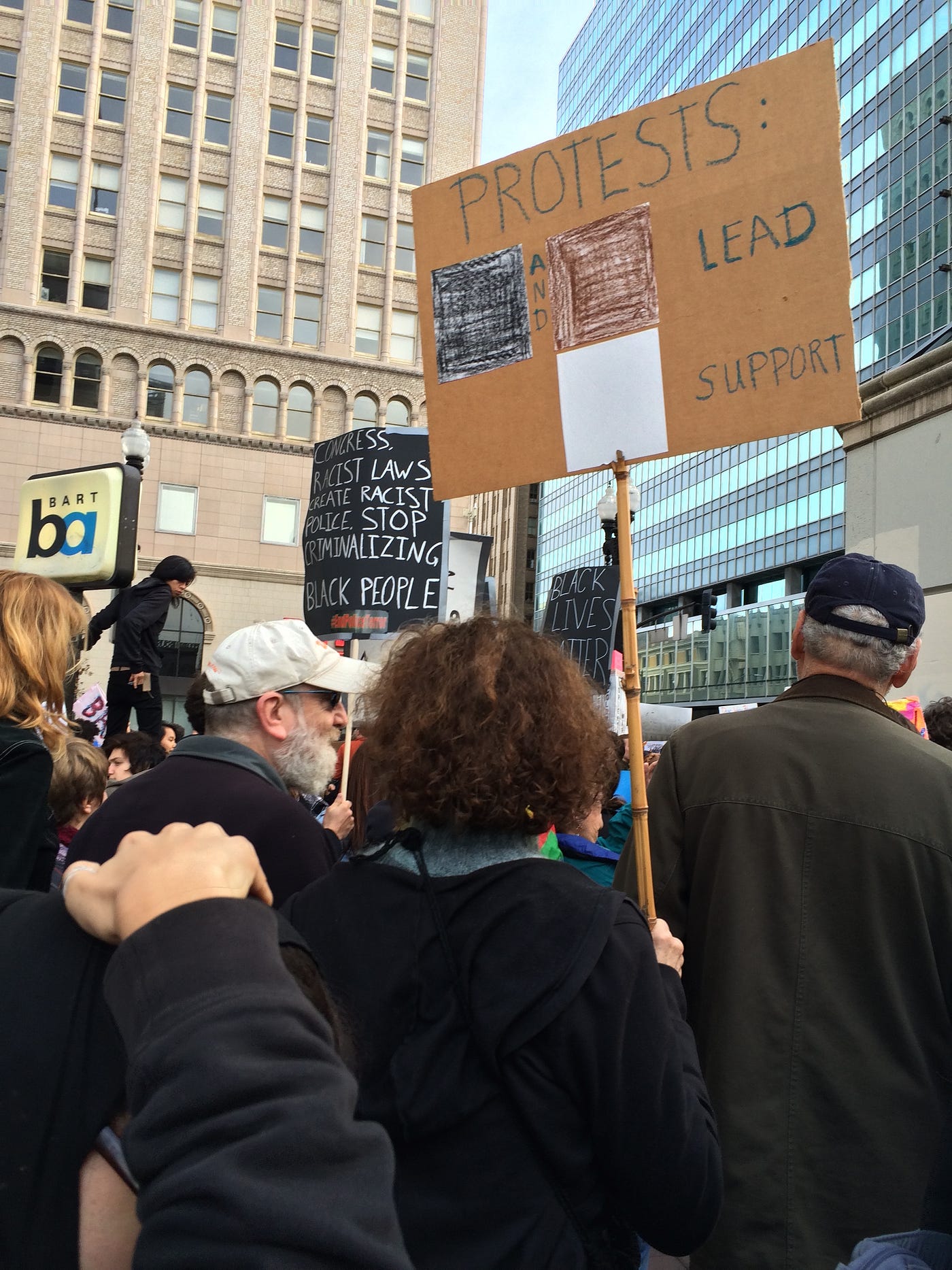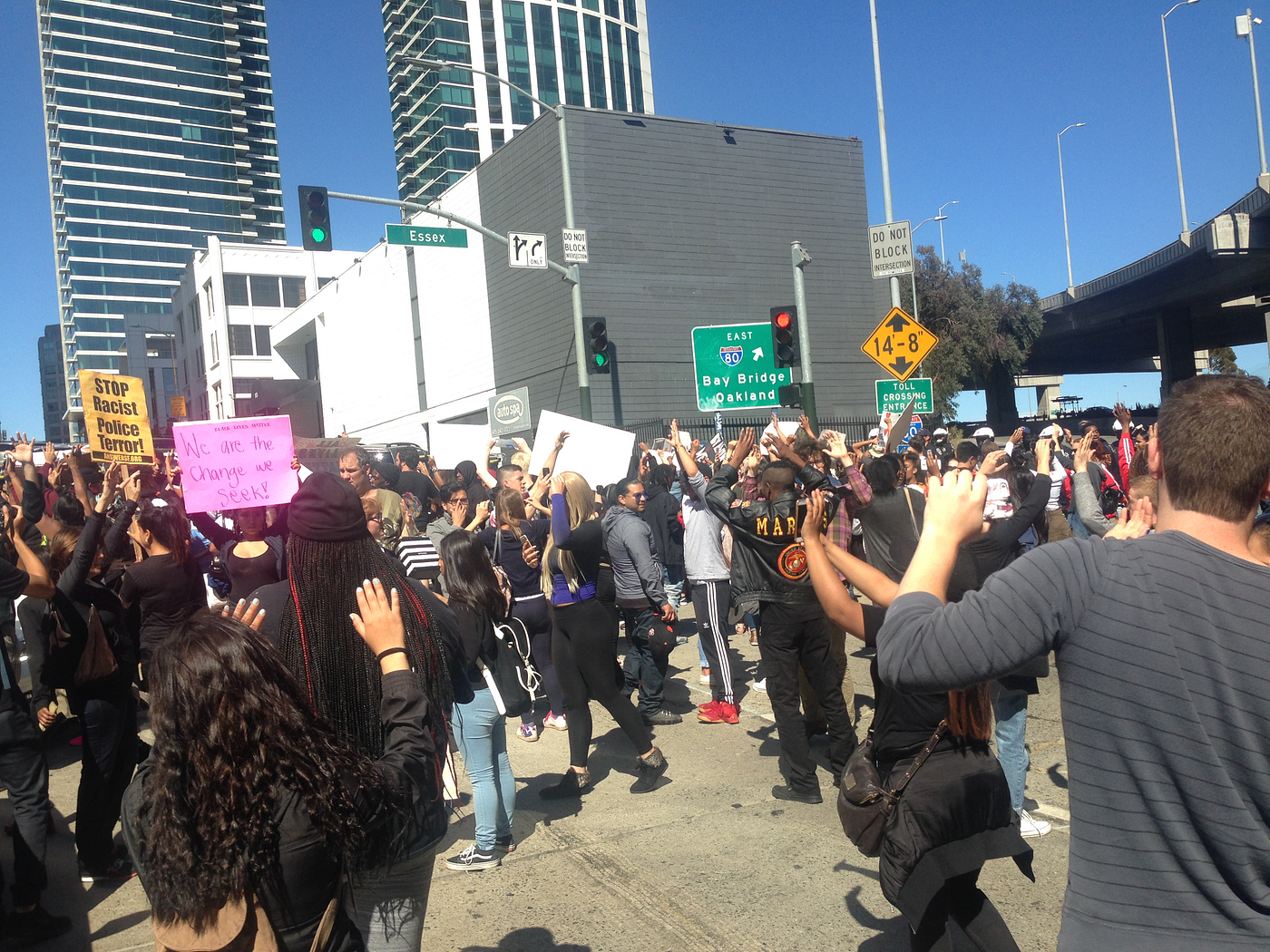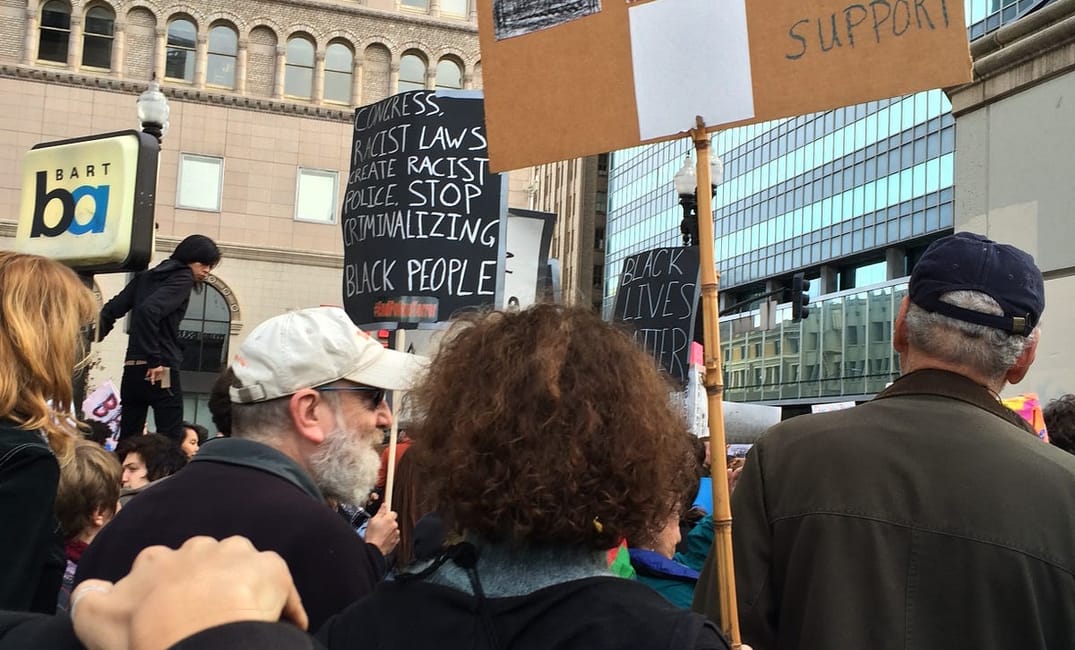
S o you’re a white person and you want to support the Black Lives Matter movement. Good. We spoke with civic leaders, organizers and activists throughout the Bay Area to find responsible and effective ways for people to contribute to this vital work.
But our conversations also revealed that there are a lot of ways in which you might think you’re helping, when in actuality you’re being an insensitive asshole. To avoid scenario number 2, let’s lay a few ground rules before we get to the action items.
Ground Rule 1: Do not expect people of color to educate you on the issues. It’s not their responsibility.
Communities of color are hurting after the deaths of Alton Sterling, Philando Castile and the recent shooting of Sylville Smith in Milwaukee. People of color need to spend their time tending to their own emotional needs, not educating white people.
In the words of civic leader and strategist Laksmi Lagares, “No one should have to explain their pain while they’re in the midst of trying to heal.”
The world is filled with amazing media in which people of color describe their experiences. So please turn to the Internet or your local library before you exhaust your grieving friend.
Ground Rule 2: Prepare to play a supportive role. You are not a leader of this movement.
White people have had the mic for too long. The movement for black lives means making way for black voices to be heard. So don’t reach for the megaphone at the rally, and prepare to walk at the back of the march.
“It’s part of the way racism works,” says activist Paul Kivel, author of Uprooting Racism: How White People Can Work for Racial Justice. “It puts white people in the limelight and gives them the sense that they’re entitled to make decisions, effectively silencing people of color and recentering white people.”
Centering on people of color is also crucial on a larger organizational scale, as we saw when speaking with the organizers of Let’s Take Action SF (LTA), a group of San Franciscans dedicated to supporting movements for racial justice.
“A lot of what we’re doing as a group is following the lead of other organizations,” said Shashi Jain, an LTA organizer. “Humility is key.”
Now to the action items …
Action Item 1: Educate yourself.
It’s pretty intuitive after the first ground rule. Understanding how racist structures are perpetuated is the first step to breaking them down.
“US history is written from a pro-European perspective,” said Joe Conte, an LTA organizer. “A lot of the criminal-justice practices on which our current system is based were developed during slavery to catch slaves. The legacy effects of those policies are still there.”
At their recent meeting, Let’s Take Action SF gave out a reading list that included The New Jim Crow by Michelle Alexander, Between the World and Me by Ta-Nehisi Coates and the aforementioned Uprooting Racism by Paul Kivel, whom we interviewed for this article.
“If a candidate doesn’t fit the Ivy League box, their chances of getting hired decrease exponentially. And what’s the result? An office culture that stays stagnant.”
But on the topic of education, Kivel explained that it is never an end goal: “Educating ourselves is a necessary step, but it must be a step toward action. It can’t become an excuse for not getting involved.”
Action Item 2: MEET YOUR NEIGHBORS!
For the Bay Area, this is one of the most important action items. How many people do you know on your block or in your building? If you can count them on one hand, that’s a problem. If they all look like you, that’s a bigger problem.
Take an afternoon and meet your neighbors IN PERSON, not on listservs or sites like Nextdoor. “These can be vehicles for racial harassment,” Kivel said. “There’s no substitute for talking to your neighbors face to face.”
“If you’ve moved to the Bay Area from somewhere else, you still need to be neighborly,” said Laksmi Lagares. “If you see your neighbor struggling with his garbage bins, offer to help. If you recognize an old woman from your block inching down the street, offer her a ride.”
If you know your neighbors, you’re also more likely to handle small issues like parking or noise face to face. That means you’re less likely to fear your neighbors and resort to bringing potentially harmful police action into the equation.

Action Item 3: Work to understand the culture of the communities you enter.
If you’re a transplant to the Bay Area, the neighborhoods you enter have existed long before you showed up. It’s our responsibility to understand and work to preserve the culture of the places we move into.
“We have to fight the displacement of the people who create culture and work for public policy that allows people to stay in their neighborhoods,” Kivel explained.
To this, some may say, “Well, didn’t I displace somebody by moving here? Is the best solution for me to just get out?” Maybe it is. But if you’re not planning on leaving, you should plan on getting involved. And you can do that by becoming an active supporter of your neighborhood’s existing community.
Action Item 4: Think before you call the police.
A quick caveat to this action item: no one is a better judge of your own safety than you are. If you feel truly unsafe, do what you think is best to attend to your safety, even if it means calling the police.
But for minor infractions, a police call can mean something different for people of color. Think of the reasons police have stated for suspecting and ultimately killing black people. Eric Garner: selling single cigarettes. Philando Castile: a traffic stop. Alton Sterling: owning a gun he was licensed to own. Michael Brown: not putting his hands up fast enough.
Granted these reasons were supplied by the police, but giving police a reason can make the use of excessive force even easier for them. Something like a noise complaint, which could result in a warning for white people, could result in fines, searches, arrests and even evictions for people of color.
“Oftentimes we operate out of a sense of white fragility,” Kivel said. “We think we’re not safe only because we’ve been trained to see people of color as dangerous.”
Action Item 5: Support businesses owned and operated by people of color.
This movement is about supporting black lives in all arenas. “It’s not just about police brutality or the displacement of individuals and families. It’s about the economic displacement and the loss of businesses run by people of color,” Kivel explained.
It’s simple economics: white businesses often begin with higher capital; they serve a gentrifying clientele that can pay higher prices; rents go up; and businesses owned and operated by people of color get pushed out. Let the homogenization begin!
This model leaves people of color behind to watch their own community become one that no longer serves their needs. “The vitality of communities depends on diverse businesses and their ability to hire local folks and provide services to local folks,” Kivel noted.
Lagares went on to give an important warning. “Understand that gentrification is an erasure of a community’s history. That’s not something you want to let happen by default.”
Action Item 6: Identify and interrupt racist behavior.
The adage goes far beyond BART trains. If you see something, say something. This can be a first line of defense against racist behavior and micro-aggressions.
When you hear a colleague or a friend make a racist comment, or if you notice someone talking over or not listening to a person of color, don’t let that behavior slide.
“Oftentimes, people don’t know that the things they say or do are disrespectful or abusive,” Kivel said. “Focus on the impact of a comment, not the intention. ‘I know you didn’t mean it that way, but X comment came off as racist for this reason.’”
The goal is to start a conversation about racism in all facets of life, so don’t hesitate to engage people about why they say and do things.
“You also have tools to keep police accountable,” Lagares said. “If you see a person of color being pulled over or harassed, pull out your phone. The ACLU [American Civil Liberties Union] has an app that allows you to upload police videos.”
Action Item 7: Talk to young white people about racism.
For parents, teachers and anyone who interacts with young people, this action item is crucial. If we don’t teach kids about issues of race, the national media will teach them for us. Young people are likely to learn division and fear over unity and acceptance if race is left unaddressed in their lives. We know these conversations can be uncomfortable, but there are great resources to help get things started. Check out Raising Race Conscious Children and SURJ Families for more information.
Action Item 8: Push your job and your organizations to reflect the diversity of the community in staff and faculty.
In the workplace, the most effective pressure comes from within. If you feel like the population of your office doesn’t reflect the population you’re trying to serve, work to change it. Pressure your HR department to hire people of color and people from nonprivileged backgrounds.
“We haven’t shifted the model on the inside,” Lagares said, referring to issues of diversity within tech. “If a candidate doesn’t fit the Ivy League box, their chances of getting hired decrease exponentially. And what’s the result? An office culture that stays stagnant.”
This can be true for any organization you’re a part of. “If you are in a space that is predominantly white, ask why,” Kivel said. “Schools, sports groups, bars and restaurants — even take a look around the house party.”
Action Item 9: Identify ways in which you can help, and play to your strengths.
Racism is not a problem that can be fixed once and then will magically disappear. Educating yourself is an important step, but it is not, as activist Krea Gomez said, “the work.” The work is making change that starts with you, not that ends with you.
“You don’t have to be standing on the freeway or getting arrested to make a difference,” Lagares said. “Identify your resources and leverage them.”
These resources can be anything from access to policy makers to influence over hiring practices at work to legal skills to time for volunteering to money for donating. Join groups like LetsTakeActionSF and your local chapter of SURJ (Showing up for Racial Justice). Host a BlackLivesMatter fundraiser, start or join a reading group, or march in solidarity. But whatever you do, do something. Racism won’t end unless we end it together.

If you’re interested in hosting a workshop, or if you need a bridge builder to consult on policy issues, Laksmi Lagares has offered to help. You can contact her at laksmilagares@gmail.com.
You can also find useful resources on Paul Kivel’s website at www.paulkivel.com.







